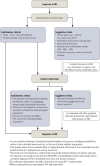Diagnosing Fracture-Related Infection: Current Concepts and Recommendations
- PMID: 31855973
- PMCID: PMC6903359
- DOI: 10.1097/BOT.0000000000001614
Diagnosing Fracture-Related Infection: Current Concepts and Recommendations
Abstract
Fracture-related infection (FRI) is a severe complication after bone injury and can pose a serious diagnostic challenge. Overall, there is a limited amount of scientific evidence regarding diagnostic criteria for FRI. For this reason, the AO Foundation and the European Bone and Joint Infection Society proposed a consensus definition for FRI to standardize the diagnostic criteria and improve the quality of patient care and applicability of future studies regarding this condition. The aim of this article was to summarize the available evidence and provide recommendations for the diagnosis of FRI. For this purpose, the FRI consensus definition will be discussed together with a proposal for an update based on the available evidence relating to the diagnostic value of clinical parameters, serum inflammatory markers, imaging modalities, tissue and sonication fluid sampling, molecular biology techniques, and histopathological examination. Second, recommendations on microbiology specimen sampling and laboratory operating procedures relevant to FRI will be provided. LEVEL OF EVIDENCE:: Diagnostic Level V. See Instructions for Authors for a complete description of levels of evidence.
Conflict of interest statement
The authors report no conflict of interest.
Figures




References
-
- Metsemakers WJ, Kortram K, Morgenstern M, et al. Definition of infection after fracture fixation: a systematic review of randomized controlled trials to evaluate current practice. Injury. 2018;49:497–504. - PubMed
-
- Parvizi J, Tan TL, Goswami K, et al. The 2018 definition of periprosthetic hip and knee infection: an evidence-based and validated criteria. J Arthroplasty. 2018;33:1309–1314 e1302. - PubMed
-
- Morgenstern M, Moriarty TF, Kuehl R, et al. International survey among orthopaedic trauma surgeons: lack of a definition of fracture-related infection. Injury. 2018;49:491–496. - PubMed
MeSH terms
Substances
LinkOut - more resources
Full Text Sources
Medical
Research Materials

